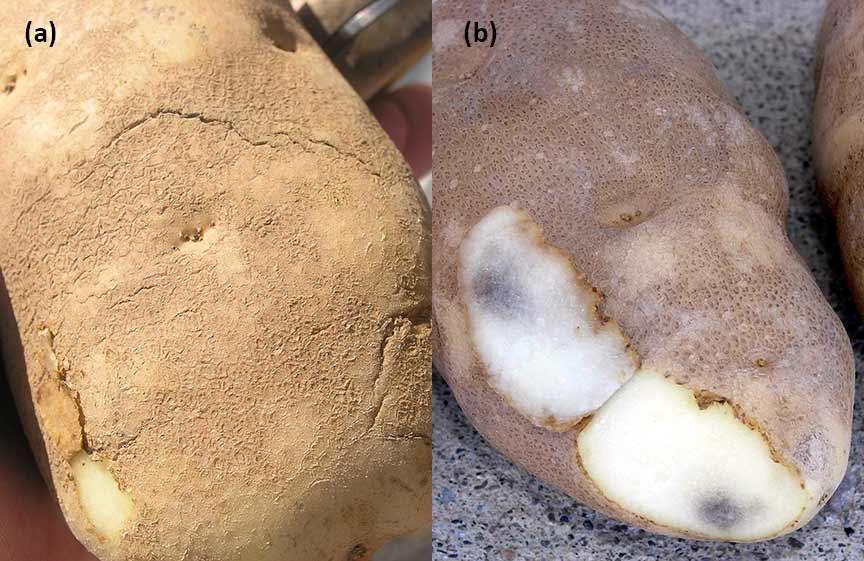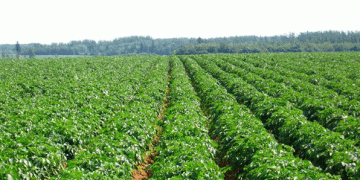It seems like each growing seasons brings a new set of production challenges related to weather or new pests. However, there are also production issues that need to be considered every year, and ignoring them risks damage to the entire crop. One constant issue that has to be addressed every year is bruise management. Very few things can ruin the market value of a good crop as fast as too much bruise.

Spring is actually the best time to start planning your bruise prevention program. This article summarizes six important factors that influence the amount of tuber damage. Additional information on bruise management can be found on the Idaho Center for Potato Research and Education website at:
- 1) Soil condition – Anything that makes soil separation from tubers at harvest more difficult has thepotential to increase bruising. So clods formed this spring may come back to cause problems next fall. Clods are hard to deal with at harvest time because just about every device used to remove them (shakers, roller tables, etc.) has the potential to injure tubers. The best way to deal with clods is toprevent their formation by following high residue crops, preparing a loose, deep soil bed, and avoiding tillage operations when soils are excessively wet. Soil moisture conditions at harvest are also important, as very wet or dry conditions make soil separation a challenge.
- 2) Tuber condition – Tuber temperature, hydration level (crispness) and maturity interact to influence bruise susceptibility. In general, the lower the pulp temperature, the more susceptible tubers are to both shatter and black spot bruising. Pulp temperatures below 45oF make it very difficult to handle potatoes without causing significant bruise damage. The more hydrated or crisp the potatoes are, the more susceptible they are to shatter bruise. In contrast, dehydrated potatoes are susceptible to black spot bruise. Likewise, as plants mature, the tubers become more susceptible to black spot bruise. Tubers that sit in dry soil under dead or dying vines can become very susceptible to black spot, so it is best to vine kill and harvest before vines reach that stage.
- 3) Harvester operation – The more susceptible the tubers are to damage, the more important it is to operate the harvester under optimum conditions. Achieving optimum harvester operation requires reducing drops, cushioning impact areas, and setting chain speeds in relation to ground speed so that harvester chains are filled to capacity. If the volume of material (tubers and soil) passing over each chain can be matched to the capacity of that chain, then damage due to excess tuber movement, rollback, and drops can all be reduced.
- 4) Bruise after the harvester – Getting potatoes into the truck with minimum damage is only the beginning of a bruise reduction program. It has been reported that about 30% of all bruise damage found on tubers in storage occurs after the harvester. Bruise reduction during the trucking and piling operations involves minimizing drops, matching conveyor speed to tuber volume, and piling in a progressive, stepwise fashion to minimize tubers rolling down the face of the pile.
- 5) Bruise on the way to market – Surveys show that potatoes can experience extensive damage during the packing, shipping and receiving operations. Fortunately, the level of damage caused during these handling steps can be significantly reduced by making minor modifications such as lowering drops, filling equipment to capacity and cushioning impact points.
- 6) The human factor – Most potato handling operations are performed by equipment, but there is almost always a human factor involved in managing that equipment in a way that minimizes bruising. Taking time to educate employees about bruise prevention should be a standard part of your harvest preparation.

Bruising occurs whenever a potato impacts another surface, typically during windrowing, harvesting, conveying, and throughout the handling and packing process. Bruises are more prevalent after potatoes fall from a significant height; hit the metal sidewalls of a conveyor; experience abrupt changes in direction; and/or collide against insufficiently padded equipment. In conjunction with force, acceleration, drop height, and impact surface, the degree of bruise development depends on tuber characteristics such as cultivar and pulp temperature. Consequently, knowing a cultivar’s response to a physical impact and the risk for bruise development are beneficial in developing a bruise prevention program.
Shatter and blackspot bruises are two main defects that influence potato quality. Both result from an impact by an external force and can occur on the same potato. Shatter bruising occurs when the external impact force is great enough to cause the cells to rupture by physically breaking the skin, where it forms cracks or cuts. Though the force may not necessarily break the skin, if it damages the underlying cells a blackspot bruise will start to develop within a few hours. The black discoloration forms when the damaged cells’ phenolic compounds (e.g., tyrosine) are oxidized by the enzyme polyphenol oxidase into a dark pigment called melanin.
Both bruise defects are serious, particularly when they cause direct and indirect losses. Losses may be from direct waste, customer rejections, weight loss, and decay due to disease. In 1993, a 10% reduction in bruise was estimated to return an additional 74.7 million dollars to the US potato industry. Adjusting only for inflation, that same 10% improvement would be equivalent to 134 million dollars in 2020. Regardless, any improvement on quality significantly enhances the potato’s economic value.
Given the economic consequences of potato bruising, it is critical to quickly identify shatter and blackspot bruising and to pinpoint where impact forces occur in an operation. This bulletin provides crucial tools and detection methods that will help make effective management decisions to minimize bruising and thus mitigate quality issues.






